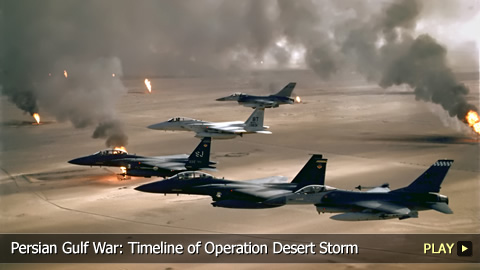Persian Gulf War: Timeline of Operation Desert Storm

Increasing Tensions
Relations between the United States and Iraq were strained for years due to Iraq’s alliance with the Soviet Union during the Cold War and their stance on other world conflicts.
Iraq’s Suffering Economy
Despite this, the U.S. helped Iraq in the war against Iran during the 1980s. While this battle helped build Iraq into an important power, it also left the country broke. In addition, Iraq’s economy suffered because of low oil prices they blamed on overproduction by Kuwait. In July 1990, Saddam Hussein’s regime threatened military action should they continue.
Iraq vs. Kuwait
Saddam also hoped to erase the debt his country owed Kuwait after the Iran-Iraq War. He wished to expand Iraq’s presence in the Middle East by controlling Kuwait’s huge oil reserves and by annexing the whole country. Due to the region’s history, he already considered Kuwait as part of Iraq.
Invasion of Kuwait
The neighboring countries failed to find a compromise, so Iraq launched a surprise invasion of Kuwait on August 2nd, 1990. Saddam claimed victory within a couple of days.
UN Trade Embargo
Meanwhile, the United Nations hoped for a quick and diplomatic end to this occupation. Iraq refused a UN request to withdraw, so the country was put under a total trade embargo.
The U.S. Gets Involved
At this point, the United States under George H.W. Bush worried that by invading Kuwait, Iraq had gained easier access to neighboring Saudi Arabia and its vast oil reserves. The U.S. hoped to contain Iraqi influence and prevent Saddam’s regime from controlling the majority of the world’s oil.
“Operation Desert Shield”
On August 7th, the U.S. and a coalition of western allies deployed troops to Saudi Arabia in a mission called “Operation Desert Shield.” This military action was based on an earlier plan created by the Commander-in-Chief of the U.S. Central Command, General Norman Schwarzkopf – otherwise known as Stormin’ Norman.
Coalition Forces
In November, the UN gave Iraq a deadline of January 15th to withdraw from Kuwait, otherwise the coalition would be permitted to respond with force. Until January, the U.S.-led coalition presence in the region grew to include soldiers from 34 countries, including Saudi Arabia, the United Kingdom and Egypt. This group was led by Schwarzkopf.
“Operation Desert Storm”
On January 16th, 1991, when Saddam’s military remained in Kuwait, “Operation Desert Storm” began. Coalition forces had a significant technological lead over their opponents, so this aerial offensive saw the demolition of Iraq’s air support, as well as much of its infrastructure and important buildings.
Tactical Retaliation
Iraq responded tactically by attacking Israel with Scud missiles. Saddam assumed he could cripple the coalition with this move because Israel had a policy of retaliation. He knew that Arab nations in the coalition would never fight alongside Israel, and so if he was able to bring them into the fray he would also be forcing those various Arab countries to leave the coalition. However, President Bush convinced Israeli Prime Minister Yitzhak Shamir not to respond.
“Operation Desert Sabre”
Iraq continued its missile attack, while the coalition initiated the war’s ground phase in an attempt to liberate Kuwait. “Operation Desert Sabre” saw coalition forces move from Saudi Arabia to Kuwait and finally to Iraq. Though the ground forces of both sides were seen as relatively equal, the Iraqi stronghold collapsed within a few days.
End of the War
On February 28th, 1991, President Bush announced the end of hostilities. Iraq agreed to acknowledge Kuwait as a distinct nation, and to rid itself of weapons of mass destruction.
2003’s Iraq War
However, Iraq failed to fully cooperate with those directives. This eventually led to the invasion of Iraq by the United States under George W. Bush in 2003, and the ensuing Iraq War.
Gulf War Syndrome
1991’s relatively short Gulf War resulted in significant Iraqi civilian and military deaths, and fewer than four hundred coalition military casualties. However, as many as 250 thousand of the almost 700 thousand coalition soldiers who served developed an illness called Gulf War Syndrome, purportedly due to the use of chemical weapons.
Legacy
This was one of the first wars to be covered live by television media. Because of this, and its impact on world history, the significance of the Gulf War resonated well into the twenty first century.